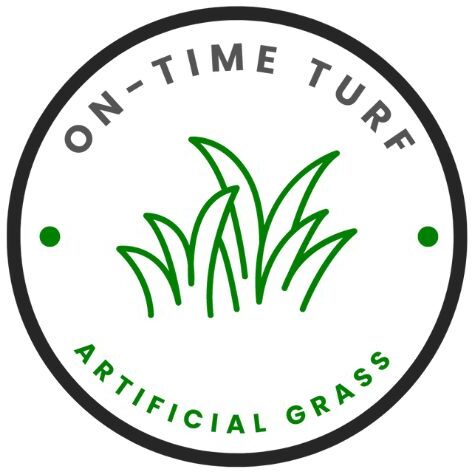FAQ
How long does an artificial lawn last?
The life expectancy of your turf depends on maintenance and use. Proper care goes a long way in maintaining a new-looking lawn. Regardless, the life expectancy of landscape turf is 15+ years. We even offer a 15-year warranty if you require a replacement.
How do I maintain an artificial lawn?
You should rinse and groom your artificial lawn installation periodically. We recommend spraying your lawn with a hose or sprinkler system for about one minute per week. You can also push a power broom through the turf areas that need attention.
You should also look out for dirty spots or fluids. PE-51 is an excellent cleaning solution and is safe for pets and kids.
Your landscape’s level of use can determine the frequency of maintenance. Higher traffic areas, such as commercial parks or sitting areas, may require more maintenance than a backyard installation.
Is artificial grass good for dogs?
There are many benefits of artificial turf for dogs. On-Time Pet Turf is non-toxic and equipped with antimicrobial technology that prevents the spread of bacteria.
Our turf can withstand high amounts of playtime, resulting in less wear and tear from your pup. If you’re looking for a pet-safe landscape alternative, our Pet Turf products are the best option.
Does artificial grass get too hot for dogs?
If you’re looking for pet turf in Miami, Fort Lauderdale, or another Florida city, you know the frequency of hot outdoor weather. Fortunately, there are ways around rising lawn temperatures if your dog wants to play outside. While artificial grass for dogs will get warmer than natural grass, it does not absorb or radiate heat like pavement, rock, or brick.
Before your pet heads outside, cool down your turf with a garden hose or sprinkler system. You can also provide a shaded area under trees or awnings so the turf will stay cooler.
Is artificial turf safe for kids?
Yes, definitely! Crumb rubber made from the ground up recycled tires are the culprits that make artificial grass unsafe. These are the properties that give artificial grass such a bad reputation. The good news is: infill is optional. Also, there are natural alternatives to it, like crushed rocks. Artificial turf with toxic amounts of lead have usually been discontinued by turf manufacturers in recent times. We’ll discuss these more in-depth in the later paragraphs.
What’s important now is that you know that generally, the artificial grass blades are safe for your kids. You can definitely have artificial turf at home without crumb rubber endangering your lives. However, there is some low-quality turf grass out there. We don’t know what they’re made of, and we can’t vouch for them either. If you want to be sure that your kids are safe, go for manufacturers that pride themselves for being non-toxic and lead- free. If you're unsure, you can always ask them for the testing certificates!
Fortunately, there are brands that go above and beyond the general rule. By offering non-toxic, lead-free, toxin-free artificial grass, On-Time Turf ensures not only your kids’ and pet's safety, but yours as well. We hired a non biased professional testing company to perform various tests on our turf, ranging from lead, UV, permeability, etc. to make sure our customers know they are getting the best products out there.
What if I have a design in mind?
Custom designs for your home artificial grass are available. You can make your synthetic grass area as unique as you want with our expert indoor and outdoor installation teams. We have extensive experience with synthetic grass lawn and are well equipped with the best products to give you the residential greatness you desire.
What is a good size for a backyard putting green?
The optimal size varies depending on your property’s square footage. A good starting point for a residential putting green is 500 square feet. Commercial putting greens typically start around 1,500 square feet, while professional courses range from 5,000 to 6,000 square feet.
Get Your Dream Project Started
For more than a decade On-Time Turf has been specializing in the design and installation of the most advanced and realistic synthetic lawns in the industry. We focus on installing projects on time, and closely with clients to ensure their installations are perfectly executed. On-Time Turf has the knowledge and experience to create the perfect solution for any landscape.

